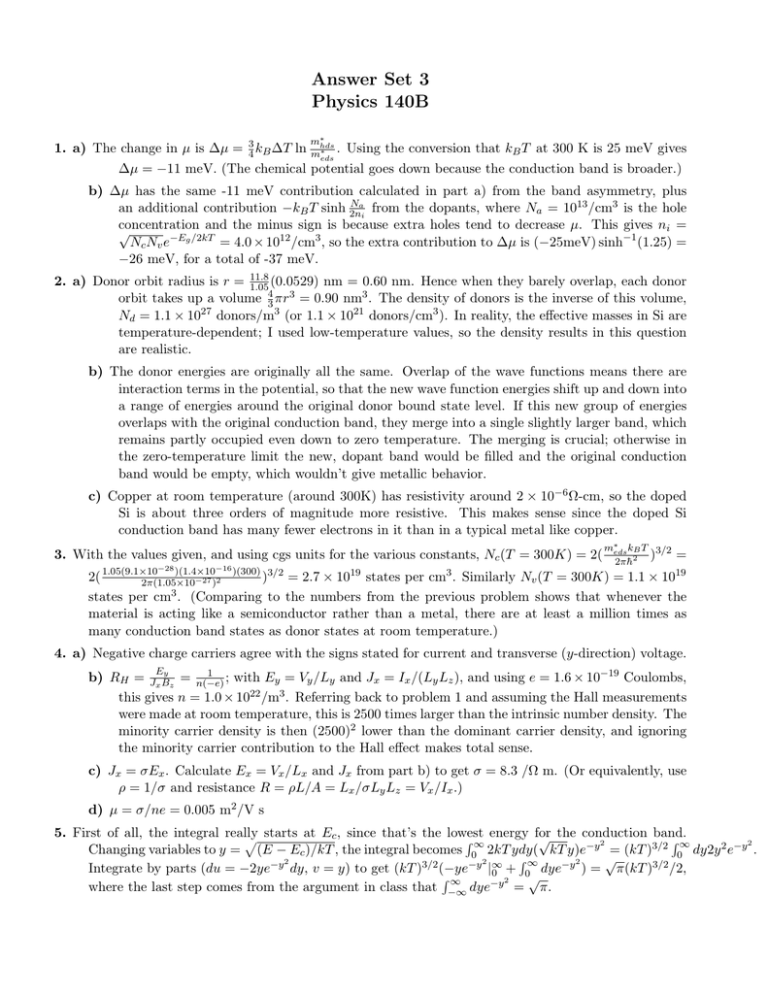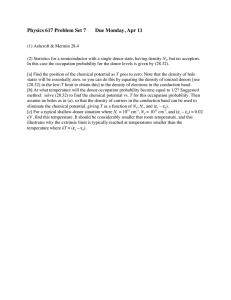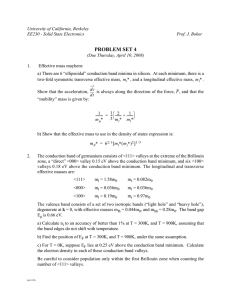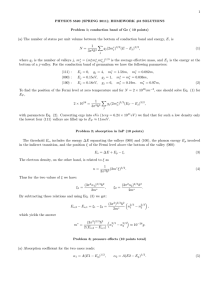Answer Set 3 Physics 140B
advertisement

Answer Set 3 Physics 140B m∗ 1. a) The change in µ is ∆µ = 43 kB ∆T ln mhds . Using the conversion that kB T at 300 K is 25 meV gives ∗ eds ∆µ = −11 meV. (The chemical potential goes down because the conduction band is broader.) b) ∆µ has the same -11 meV contribution calculated in part a) from the band asymmetry, plus Na from the dopants, where Na = 1013 /cm3 is the hole an additional contribution −kB T sinh 2n i concentration and the minus sign is because extra holes tend to decrease µ. This gives ni = √ −E /2kT g Nc Nv e = 4.0 × 1012 /cm3 , so the extra contribution to ∆µ is (−25meV) sinh−1 (1.25) = −26 meV, for a total of -37 meV. 11.8 2. a) Donor orbit radius is r = 1.05 (0.0529) nm = 0.60 nm. Hence when they barely overlap, each donor 4 orbit takes up a volume 3 πr3 = 0.90 nm3 . The density of donors is the inverse of this volume, Nd = 1.1 × 1027 donors/m3 (or 1.1 × 1021 donors/cm3 ). In reality, the effective masses in Si are temperature-dependent; I used low-temperature values, so the density results in this question are realistic. b) The donor energies are originally all the same. Overlap of the wave functions means there are interaction terms in the potential, so that the new wave function energies shift up and down into a range of energies around the original donor bound state level. If this new group of energies overlaps with the original conduction band, they merge into a single slightly larger band, which remains partly occupied even down to zero temperature. The merging is crucial; otherwise in the zero-temperature limit the new, dopant band would be filled and the original conduction band would be empty, which wouldn’t give metallic behavior. c) Copper at room temperature (around 300K) has resistivity around 2 × 10−6 Ω-cm, so the doped Si is about three orders of magnitude more resistive. This makes sense since the doped Si conduction band has many fewer electrons in it than in a typical metal like copper. 3. With the values given, and using cgs units for the various constants, Nc (T = 300K) = 2( −28 )(1.4×10−16 )(300) 2( 1.05(9.1×10 )3/2 = 2.7 × 1019 2π(1.05×10−27 )2 states per cm3 . (Comparing to the numbers cm3 . m∗eds kB T 3/2 ) 2πh̄2 = 1.1 × 1019 states per Similarly Nv (T = 300K) = from the previous problem shows that whenever the material is acting like a semiconductor rather than a metal, there are at least a million times as many conduction band states as donor states at room temperature.) 4. a) Negative charge carriers agree with the signs stated for current and transverse (y-direction) voltage. E 1 b) RH = Jx By z = n(−e) ; with Ey = Vy /Ly and Jx = Ix /(Ly Lz ), and using e = 1.6 × 10−19 Coulombs, this gives n = 1.0 × 1022 /m3 . Referring back to problem 1 and assuming the Hall measurements were made at room temperature, this is 2500 times larger than the intrinsic number density. The minority carrier density is then (2500)2 lower than the dominant carrier density, and ignoring the minority carrier contribution to the Hall effect makes total sense. c) Jx = σEx . Calculate Ex = Vx /Lx and Jx from part b) to get σ = 8.3 /Ω m. (Or equivalently, use ρ = 1/σ and resistance R = ρL/A = Lx /σLy Lz = Vx /Ix .) d) µ = σ/ne = 0.005 m2 /V s 5. First of all, the integral really energy for band. √ the conduction p starts at Ec , since that’s the lowest R∞ R∞ 2 −y 3/2 2 −y 2 . Changing variables to y = (E − Ec )/kT , the integral becomes 0 2kT ydy( kT y)e = (kT ) 0 dy2y e R √ 2 2 ∞ −y 2 ) = Integrate by parts (du = −2ye−y dy, v = y) to get (kT )3/2 (−ye−y |∞ π(kT )3/2 /2, 0 + 0 dye R∞ √ 2 where the last step comes from the argument in class that −∞ dye−y = π.





